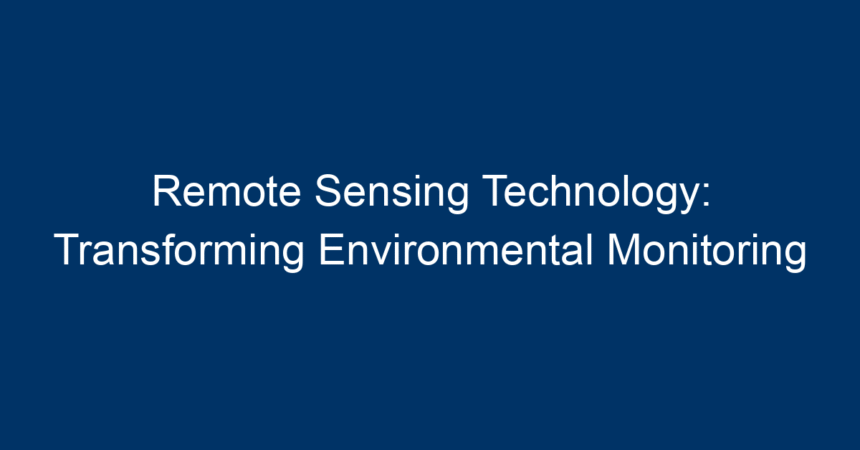In an age where climate change is a pressing global issue, remote sensing technology is emerging as a crucial ally in environmental monitoring. By utilizing satellites, drones, and other airborne sensors, scientists and environmentalists are equipped with the tools needed to observe, analyze, and make informed decisions regarding the Earth’s health. This article delves into how remote sensing technology is transforming environmental monitoring and its implications for our planet’s future.
What is Remote Sensing Technology?
Remote sensing technology refers to the collection of information about an object or area from a distance, typically from satellites or aircraft. It captures data across various spectrums such as visible light, infrared, and microwave radiation, providing valuable insights into the Earth’s surface without the need for physical contact.
The technology works through two primary types: active and passive remote sensing. Active sensors emit their own energy to scan objects, while passive sensors detect the natural energy reflected from the Earth. Both methods serve distinct yet complementary roles in data gathering for environmental monitoring.
The Significance of Remote Sensing Technology
-
Data Collection at Scale: Traditional monitoring methods can be time-consuming and limited in scope. Remote sensing technology provides comprehensive data across large areas, making it easier to track environmental changes over time.
-
Real-time Monitoring: The ability to gather data in near real-time facilitates timely responses to environmental challenges. For instance, satellite imagery can detect forest fires, flooding, or drought conditions as they occur.
- Cost-effectiveness: Deploying remote sensing technology can often be more economical in the long run. It reduces the need for extensive field investigations and manual data collection, allowing resources to be focused on analysis and decision-making.
Applications of Remote Sensing Technology in Environmental Monitoring
1. Climate Change Studies
Remote sensing technology plays a pivotal role in understanding climate dynamics. By analyzing spatial and temporal data related to atmospheric conditions, researchers can better grasp trends in temperature changes, greenhouse gas emissions, and land use alterations. For instance, NASA’s Earth Observing System satellites monitor vital climate variables, allowing scientists to create predictive models of future climate scenarios.
2. Deforestation and Land Use Change
The continuous monitoring of forests is paramount to combating deforestation. Remote sensing tools provide invaluable insights into vegetation changes, biodiversity loss, and habitat destruction. Drones equipped with high-resolution cameras can visually capture and assess forest health, while satellite data can reveal larger patterns of land use change, aiding conservation efforts.
3. Water Quality and Resources
Remote sensing technology is instrumental in tracking water bodies’ quality and availability. Satellites can measure chlorophyll levels in oceans and freshwater sources, helping detect pollution and algal blooms. Additionally, monitoring changes in snow cover and glacial melt provides critical data on freshwater resources pivotal for human consumption and agriculture.
4. Urban Planning
As cities expand, effective urban planning is essential to manage environmental impacts. Remote sensing technology offers city planners valuable information on land cover, Vegetation Index (NDVI), and urban heat islands. Access to this data fosters sustainable development practices that promote ecological balance.
5. Disaster Management
Remote sensing is a game-changer in disaster response. In emergencies such as earthquakes, floods, and hurricanes, rapid satellite imagery allows decision-makers to assess damage and allocate resources efficiently. Furthermore, the predictive capabilities of remote sensing can help identify regions at risk, enhancing preparedness strategies.
Challenges of Remote Sensing Technology
Despite its numerous advantages, remote sensing technology isn’t without challenges. These hurdles include:
1. Data Overload
The vast amount of data generated can overwhelm analysts, necessitating advanced analytical tools and algorithms to extract meaningful insights. The challenge lies in developing automated systems that can process and interpret data efficiently.
2. Technical Limitations
Cloud cover, atmospheric conditions, and sensor limitations can impact the accuracy of remote sensing data. Ongoing technological advancements are needed to improve the reliability and resolution of the data collected.
3. Accessibility and Cost
While the costs of remote sensing technology have decreased, access to high-quality data can still be limited for developing nations. Collaborative efforts and funding are crucial in ensuring equitable access to these tools.
Future Prospects of Remote Sensing Technology
The future of remote sensing technology is promising, with continuous advancements expected to enhance its capabilities:
1. Integration with Artificial Intelligence (AI)
The combination of remote sensing and AI has the potential to revolutionize data analysis. Machine learning algorithms can assist in deciphering patterns and trends in vast datasets, leading to quicker decision-making processes.
2. Enhanced Sensor Technology
The development of smaller, more resilient sensors will facilitate greater flexibility in data collection, including the ability to gather information in previously inaccessible regions.
3. Citizen Science and Community Engagement
Encouraging public participation in data collection via smartphones and drones can democratize remote sensing technology. Building community awareness and involving citizens in environmental monitoring fosters a sense of stewardship towards natural resources.
Conclusion: Embracing Remote Sensing Technology for a Sustainable Future
Remote sensing technology is not merely a tool; it’s a transformative approach to environmental monitoring. Its ability to provide high-quality, large-scale data about our planet equips policymakers, researchers, and activists with critical insights necessary for mitigating environmental challenges.
To leverage these advancements, collaboration among governments, scientists, and the private sector is vital. Furthermore, public awareness and involvement can foster a culture of sustainability.
As we embrace the potential of remote sensing technology, we must commit to nurturing our planet and ensuring a sustainable future for generations to come. Invest in remote sensing capabilities today to pave the way for a healthier tomorrow.




